[English] 日本語
 Yorodumi
Yorodumi- PDB-5lvz: Crystal structure of yeast 14-3-3 protein from Lachancea thermoto... -
+ Open data
Open data
- Basic information
Basic information
| Entry | Database: PDB / ID: 5lvz | |||||||||
|---|---|---|---|---|---|---|---|---|---|---|
| Title | Crystal structure of yeast 14-3-3 protein from Lachancea thermotolerans | |||||||||
 Components Components | KLTH0G14146p | |||||||||
 Keywords Keywords |  SIGNALING PROTEIN / SIGNALING PROTEIN /  14-3-3 14-3-3 | |||||||||
| Function / homology |  Function and homology information Function and homology information14-3-3 domain / Delta-Endotoxin; domain 1 / 14-3-3 proteins signature 2. / 14-3-3 protein, conserved site / 14-3-3 proteins signature 1. /  14-3-3 protein / 14-3-3 homologues / 14-3-3 domain / 14-3-3 domain superfamily / 14-3-3 protein / 14-3-3 homologues / 14-3-3 domain / 14-3-3 domain superfamily /  14-3-3 protein ...14-3-3 domain / Delta-Endotoxin; domain 1 / 14-3-3 proteins signature 2. / 14-3-3 protein, conserved site / 14-3-3 proteins signature 1. / 14-3-3 protein ...14-3-3 domain / Delta-Endotoxin; domain 1 / 14-3-3 proteins signature 2. / 14-3-3 protein, conserved site / 14-3-3 proteins signature 1. /  14-3-3 protein / 14-3-3 homologues / 14-3-3 domain / 14-3-3 domain superfamily / 14-3-3 protein / 14-3-3 homologues / 14-3-3 domain / 14-3-3 domain superfamily /  14-3-3 protein / Up-down Bundle / Mainly Alpha 14-3-3 protein / Up-down Bundle / Mainly AlphaSimilarity search - Domain/homology | |||||||||
| Biological species |   Lachancea thermotolerans (fungus) Lachancea thermotolerans (fungus) | |||||||||
| Method |  X-RAY DIFFRACTION / X-RAY DIFFRACTION /  SYNCHROTRON / SYNCHROTRON /  MOLECULAR REPLACEMENT / Resolution: 1.95 Å MOLECULAR REPLACEMENT / Resolution: 1.95 Å | |||||||||
 Authors Authors | Klima, M. / Boura, E. | |||||||||
 Citation Citation |  Journal: Acta Crystallogr.,Sect.F / Year: 2016 Journal: Acta Crystallogr.,Sect.F / Year: 2016Title: Crystal structures of a yeast 14-3-3 protein from Lachancea thermotolerans in the unliganded form and bound to a human lipid kinase PI4KB-derived peptide reveal high evolutionary conservation. Authors: Eisenreichova, A. / Klima, M. / Boura, E. | |||||||||
| History |
|
- Structure visualization
Structure visualization
| Structure viewer | Molecule:  Molmil Molmil Jmol/JSmol Jmol/JSmol |
|---|
- Downloads & links
Downloads & links
- Download
Download
| PDBx/mmCIF format |  5lvz.cif.gz 5lvz.cif.gz | 60.8 KB | Display |  PDBx/mmCIF format PDBx/mmCIF format |
|---|---|---|---|---|
| PDB format |  pdb5lvz.ent.gz pdb5lvz.ent.gz | 44 KB | Display |  PDB format PDB format |
| PDBx/mmJSON format |  5lvz.json.gz 5lvz.json.gz | Tree view |  PDBx/mmJSON format PDBx/mmJSON format | |
| Others |  Other downloads Other downloads |
-Validation report
| Arichive directory |  https://data.pdbj.org/pub/pdb/validation_reports/lv/5lvz https://data.pdbj.org/pub/pdb/validation_reports/lv/5lvz ftp://data.pdbj.org/pub/pdb/validation_reports/lv/5lvz ftp://data.pdbj.org/pub/pdb/validation_reports/lv/5lvz | HTTPS FTP |
|---|
-Related structure data
| Related structure data | 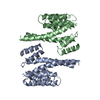 1a4oS S: Starting model for refinement |
|---|---|
| Similar structure data |
- Links
Links
- Assembly
Assembly
| Deposited unit | 
| ||||||||
|---|---|---|---|---|---|---|---|---|---|
| 1 | 
| ||||||||
| Unit cell |
|
- Components
Components
| #1: Protein | Mass: 28603.861 Da / Num. of mol.: 1 Source method: isolated from a genetically manipulated source Source: (gene. exp.)   Lachancea thermotolerans (strain ATCC 56472 / CBS 6340 / NRRL Y-8284) (fungus) Lachancea thermotolerans (strain ATCC 56472 / CBS 6340 / NRRL Y-8284) (fungus)Gene: KLTH0G14146g / Production host:   Escherichia coli BL21 (bacteria) / References: UniProt: C5DN49 Escherichia coli BL21 (bacteria) / References: UniProt: C5DN49 |
|---|---|
| #2: Water | ChemComp-HOH /  Water Water |
-Experimental details
-Experiment
| Experiment | Method:  X-RAY DIFFRACTION / Number of used crystals: 1 X-RAY DIFFRACTION / Number of used crystals: 1 |
|---|
- Sample preparation
Sample preparation
| Crystal | Density Matthews: 2.7 Å3/Da / Density % sol: 54.36 % |
|---|---|
Crystal grow | Temperature: 291 K / Method: vapor diffusion, hanging drop / Details: 13% PEG 3350, 190 mM CaCl2, 3% glycerol |
-Data collection
| Diffraction | Mean temperature: 100 K |
|---|---|
| Diffraction source | Source:  SYNCHROTRON / Site: SYNCHROTRON / Site:  BESSY BESSY  / Beamline: 14.1 / Wavelength: 0.97625 Å / Beamline: 14.1 / Wavelength: 0.97625 Å |
| Detector | Type: DECTRIS PILATUS 6M / Detector: PIXEL / Date: Aug 29, 2015 |
| Radiation | Protocol: SINGLE WAVELENGTH / Monochromatic (M) / Laue (L): M / Scattering type: x-ray |
| Radiation wavelength | Wavelength : 0.97625 Å / Relative weight: 1 : 0.97625 Å / Relative weight: 1 |
| Reflection | Resolution: 1.95→44.34 Å / Num. obs: 23282 / % possible obs: 99.91 % / Redundancy: 8.4 % / Biso Wilson estimate: 36.46 Å2 / CC1/2: 0.999 / Rmerge(I) obs: 0.09166 / Rsym value: 0.09166 / Net I/σ(I): 14.26 |
| Reflection shell | Resolution: 1.95→2.02 Å / Redundancy: 8.7 % / Rmerge(I) obs: 1.323 / Mean I/σ(I) obs: 1.48 / CC1/2: 0.617 / % possible all: 99.96 |
- Processing
Processing
| Software |
| |||||||||||||||||||||||||||||||||||||||||||||
|---|---|---|---|---|---|---|---|---|---|---|---|---|---|---|---|---|---|---|---|---|---|---|---|---|---|---|---|---|---|---|---|---|---|---|---|---|---|---|---|---|---|---|---|---|---|---|
| Refinement | Method to determine structure : :  MOLECULAR REPLACEMENT MOLECULAR REPLACEMENTStarting model: 1A4O Resolution: 1.95→44.34 Å / SU ML: 0.23 / Cross valid method: FREE R-VALUE / σ(F): 1.36 / Phase error: 22.5
| |||||||||||||||||||||||||||||||||||||||||||||
| Solvent computation | Shrinkage radii: 0.9 Å / VDW probe radii: 1.11 Å | |||||||||||||||||||||||||||||||||||||||||||||
| Displacement parameters | Biso mean: 43.5 Å2 | |||||||||||||||||||||||||||||||||||||||||||||
| Refinement step | Cycle: LAST / Resolution: 1.95→44.34 Å
| |||||||||||||||||||||||||||||||||||||||||||||
| Refine LS restraints |
| |||||||||||||||||||||||||||||||||||||||||||||
| LS refinement shell | Refine-ID: X-RAY DIFFRACTION / % reflection Rfree: 5 % / % reflection obs: 100 %
|
 Movie
Movie Controller
Controller


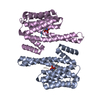
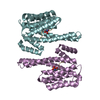


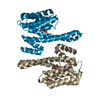
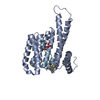

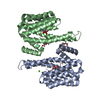
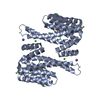

 PDBj
PDBj

